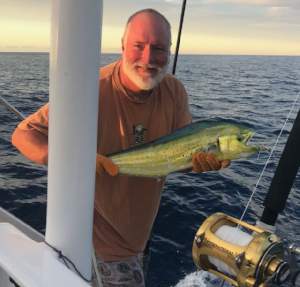Day 3 was uneventful. Motored all day but put the sail out a few times which added .5 to 1.5 kts of additional speed. We’ve also been getting 1/2 knot of current in our favor so that helps. We burned a total of 40 galons of fuel so far so we still have plenty of buffer to motor a large part of the trip if necessary. Got new weather forecast that confirms what we’ve seen for the last several days so I’ve diverter to a more easterly route that could shave off a few miles. Trip computer says we have 2,373nm to go. At our normal estimate of 150 miles per day that would put us in Barbados in 16 days (Friday the 15th of Dec) but it looks like it’s going to be slower.
We didn’t see any ships today but yesterday we saw a megayacht that came to within about 5 miles. It looked like it was really close but those big tripple deckers are deceptively large.
Tonight I will finish my book on Andrew Jackson. Pretty interesting about how fragile the Union of The States was in the 1820’s. At this point the big issue was about tariffs on cotton and states rights. Jackson was agressive by nature and very agressive about keeping the Union together. As our frist populist president he also had a strong belief about term limits and how power corrupts. To me, politics hasn’t changed much in the last 200 years of our United States Democracy. Seems to be an ongoing experiment and kind of like Agile Software Development. Many men have come close to blowing it up in the past for power, greed, ego etc. I believe we have come a long way.

Hey, sailors–reading about Jackson put you right where the news is this week, with the President honoring the famous Navajo “Code Talkers” in front of Jackson’s picture. Hope you don’t mind this long post ( cut and paste)–just a one time tie-in to your reading. And a link to your politics and populism notes–not much has changed.
The prominent placement of an Andrew Jackson portrait during an event meant to honor a group of Native Americans at the Oval Office on Monday has raised questions about the White House’s message.
Jackson is known for his harsh treatment of Native Americans as president, famously signing the Indian Removal Act, which led to thousands of Native American deaths as tens of thousands were forced to relocate. Some observers thought the juxtaposition of his portrait during the event with the stated purpose of honoring three Navajo code talkers was strange.
“We noticed,” said Jacqueline Pata, executive director of the National Congress of American Indians. “Andrew Jackson wasn’t necessarily a president who was respectful of tribal governments and Native Americans. This is one of those eras that is probably bleaker in terms of the relationship between Native Americans and the federal government.”
The portrait is visible for the entirety of the White House’s 17-minute broadcast of the event.
As president from 1829 to 1837, Jackson is perhaps most famous for his pivotal role in Native Americans’ painful and violent history in the United States. He signed the Indian Removal Act in 1830, which forced the relocation of more than 60,000 Native Americans to clear the way for white pioneers. The act helped lead to the “Trail of Tears,” in which an estimated 4,000 Cherokee died during the harsh conditions of a long march during a forced relocation in 1838 and 1839. The Cherokees called Jackson “Indian killer”; the Creek called him “Sharp Knife.”
A slave owner, Jackson spoke about Native Americans as if they were an inferior group of people. “Established in the midst of a superior race,” he said of the Cherokee, “they must disappear.”Removing Native Americans from their land would “enable them to pursue happiness in their own way, and under their own rude institutions,” he said.
Trump’s affinity for Jackson has long been a facet of his public image as a politician. He lambasted an Obama administration plan, which has not yet taken effect, to remove Jackson from the $20 bill in favor of abolitionist Harriet Tubman, referring to Jackson during the presidential campaign as someone with “a history of tremendous success for the country.” And just days after his inauguration in January, Trump selected a portrait of Jackson in the Oval Office. In March, he stopped by the Hermitage, Jackson’s home in Tennessee, to lay a wreath at the former president’s tomb. The president’s former chief strategist, Stephen K. Bannon, lauded Trump’s inauguration address as “Jacksonian.” Pata said she wanted to assume the symbolism wasn’t intentional.
As the president spoke to honor the three code talkers Monday, he lobbed the nickname “Pocahontas” at Democratic Sen. Elizabeth Warren (Mass.), which many consider to be a racial slur.
Gyasi Ross, an author from Washington state and member of the Blackfeet Nation tribe, said he considered the portrait’s prominence during the news conference to be an intentional slight.“It’s an incredibly distasteful wink in front of people who have sacrificed so much,” he said. “Donald Trump is not a stupid man. He understands visuals and optics: His background is in television. So all of that stuff, I believe, is very deliberate.”
He said the insult was magnified by the nature of the event.
“Elders and veterans, we take those two things very seriously,” he said, speaking about Native Americans. “And so to people who take that seriously, all of these things are incredibly consequential.”
Mihio Manus, a spokesman for the president and vice president of the Navajo Nation, said the placement of the Jackson portrait was “unfortunate.”
Loving your “crossing” blog posts. Good luck on finding some wind.
Tom